Sustainability Perceptions in Tourism and Hospitality: A Mixed-Method Bibliometric Approach
Abstract
1. Introduction
2. Tourists’ Perceptions
3. Bibliometric Studies in Tourism and Hospitality
4. Methodology
4.1. Data Collection and Systematization Procedures
4.2. Data Analysis Procedures
5. Results
5.1. Bibliometric Evaluative Results: Productivity and Impact Metric Structure of SPTH
5.2. Bibliometric Relational Results
5.3. Bibliometric Systematic Review: Tourists’, Residents’ and Stakeholders’ SPTH Structure
6. Discussion
7. Conclusions
Author Contributions
Funding
Conflicts of Interest
References
- Agapito, D.; Pinto, P.; Mendes, J. Tourists’ memories, sensory impressions and loyalty: In loco and post-visit study in Southwest Portugal. Tour. Manag. 2017, 58, 108–118. [Google Scholar] [CrossRef]
- Cardoso, L.; Dias, F.; de Araújo, A.; Marques, I. A destination imagery processing model: Structural differences between dream and favourite destinations. Ann. Tour. Res. 2019, 74, 81–94. [Google Scholar] [CrossRef]
- Dias, F.; Cardoso, L. How can brand equity for tourism destinations be used to preview tourists’ destination choice? An overview from the top of Tower of Babel. Tour. Manag. Stud. 2017, 13, 13–23. [Google Scholar] [CrossRef]
- Tavares, J.M.; Tran, X.; Pennington-Grey, L. Destination images of the ten most visited countries for potential Brazilian tourists. Tour. Manag. Stud. 2020, 16, 43–50. [Google Scholar] [CrossRef]
- Stern, P.C. New environmental theories: Toward a coherent theory of environmentally significant behavior. J. Soc. Issues 2000, 56, 407–424. [Google Scholar] [CrossRef]
- Paunović, I.; Jovanović, V. Sustainable mountain tourism in word and deed: A comparative analysis in the macro regions of the Alps and the Dinarides. Acta Geogr. Slov. 2019, 59, 59–69. [Google Scholar] [CrossRef]
- Jetter, L.G.; Chen, R.J. Destination branding and images: Perceptions and practices from tourism industry professionals. Int. J. Hosp. Tour. Adm. 2011, 12, 174–187. [Google Scholar] [CrossRef]
- Masri, N.; Anuar, F.I.; Yulia, A. Influence of Wi-Fi service quality towards tourists’ satisfaction and dissemination of tourism experience. J. Tour. Hosp. Culin. Arts 2017, 9, 1–16. [Google Scholar]
- Fernández-Gámez, M.A.; Bendodo-Benasayag, B.; Sánchez-Serrano, J.R.; Pestana, M.H. Hybrid preference assessment for tourism research using solicited and unsolicited opinions: An application in rural tourism. Tour. Manag. Stud. 2020, 16, 7–13. [Google Scholar]
- Pinto, I.; Castro, C. Online travel agencies: Factors influencing tourists’ purchase decisions. Tour. Manag. Stud. 2019, 15, 7–20. [Google Scholar] [CrossRef]
- McFee, A.; Mayrhofer, T.; Baràtovà, A.; Neuhofer, A. The Effects of Virtual Reality on Destination Image Formation. In Information and Communication Technologies in Tourism; McFee, A., Mayrhofer, T., Baràtovà, A., Neuhofer, B., Rainoldi, M., Egger, R., Eds.; Springer: Cham, Switzerland, 2019; pp. 107–119. [Google Scholar]
- Pasanen, K.; Pesonen, J.; Murphy, J.; Heinonen, J.; Mikkonen, J. Comparing Tablet and Virtual Reality Glasses for Watching Nature Tourism Videos. In Information and Communication Technologies in Tourism; McFee, A., Mayrhofer, T., Baràtovà, A., Neuhofer, B., Rainoldi, M., Egger, R., Eds.; Springer: Cham, Switzerland, 2019; pp. 120–131. [Google Scholar]
- Melo, F.V.S.; Farias, S.A. Sustainability communication and its effect in consumer intention to visit a tourist destination. Tour. Manag. Stud. 2018, 14, 36–44. [Google Scholar] [CrossRef]
- Baum, T.; Hai, N.T.T. Hospitality, tourism, human rights and the impact of COVID-19. Int. J. Contemp. Hosp. Manag. 2020, 32, 2397–2407. [Google Scholar] [CrossRef]
- Chein, J.M.; Ravizza, S.M.; Fiez, J.A. Using neuroimaging to evaluate models of working memory and their implications for language processing. J. Neurolinguist. 2003, 16, 315–339. [Google Scholar] [CrossRef]
- Zimmermann, J.F.; Moscovitch, M.; Alain, C. Attending to auditory memory. Brain Res. 2016, 1640, 208–221. [Google Scholar] [CrossRef]
- De Araújo, A.; Cardoso, L.; Araújo-Vila, N.; Dias, F. Understanding the role of destination imagery in mountain destination choice. Evidence from an exploratory research. Eur. J. Tour. Res. 2019, 22, 151–165. [Google Scholar]
- Lin, C.T.; Huang, Y.L. Mining tourist imagery to construct destination image position model. Expert Syst. Appl. 2009, 36, 2513–2524. [Google Scholar] [CrossRef]
- Dort, M.; Strelow, A.E.; French, B.; Groom, M.; Luman, M.; Thorell, L.B.; Biele, G.; Christiansen, H. Bibliometric Review: Classroom Management in ADHD—Is There a Communication Gap Concerning Knowledge Between the Scientific Fields Psychiatry/Psychology and Education? Sustainability 2020, 12, 6826. [Google Scholar] [CrossRef]
- Koseoglu, M.A.; Rahimi, R.; Okumus, F.; Liu, J. Bibliometric studies in tourism. Ann. Tour. Res. 2016, 61, 180–198. [Google Scholar] [CrossRef]
- Small, H.; Boyack, K.W.; Klavans, R. Identifying emerging topics in science and technology. Res. Policy 2014, 43, 1450–1467. [Google Scholar] [CrossRef]
- Klavans, R.; Boyack, K.W. Research Portfolio analysis and topic prominence. J. Informetr. 2017, 11, 1158–1174. [Google Scholar] [CrossRef]
- Mudarra-Fernández, A.B.; Carrillo-Hidalgo, I.; Pulido-Fernández, J.I. Factors influencing tourist expenditure by tourism typologies: A systematic review. Anatolia 2018, 30, 18–34. [Google Scholar] [CrossRef]
- Fahimnia, B.; Sarkis, J.; Davarzani, H. Green supply chain management: A review and bibliometric analysis. Int. J. Prod. Econ. 2015, 162, 101–114. [Google Scholar] [CrossRef]
- Mulet-Forteza, C.; Martorell-Cunill, O.; Merigó, J.M.; Genovart-Balaguer, J.; Mauleon-Mendez, E. Twenty-five years of the Journal of Travel & Tourism Marketing: A bibliometric ranking. J. Travel Tour. Mark. 2018, 35, 1201–1221. [Google Scholar]
- Merigó, J.M.; Mulet-Forteza, C.; Martorell, O.; Merigó-Lindahl, C. Scientific research in the tourism, leisure and hospitality field: A bibliometric analysis. Anatolia 2020, 31, 1–15. [Google Scholar] [CrossRef]
- Andalial, R.C.; LabradaII, R.R.; Castells, M.M. Scopus: La mayor base de datos de literatura científica arbitrada al alcance de los países subdesarrollados. Rev. Cuba. Inf. Cienc. Salud (ACIMED) 2010, 21, 270–282. [Google Scholar]
- Bosman, J.; Mourik, I.V.; Rasch, M.; Sieverts, E.; Verhoeff, H. Scopus Reviewed and Compared: The Coverage and Functionality of the Citation Database Scopus, Including Comparisons with Web of Science and Google Scholar; Utrecht University Library: Utrecht, The Netherlands, 2006. [Google Scholar]
- Aria, M.; Cuccurullo, C. Bibliometrix: An R-tool for comprehensive science mapping analysis. J. Informetr. 2017, 11, 959–975. [Google Scholar] [CrossRef]
- Bardin, L. Análise de Conteúdo; Edições 70: Lisbon, Portugal, 2000. [Google Scholar]
- Wilson, E.; Mura, P.; Sharif, S.P.; Wijesinghe, S.N.R. Beyond the third moment? Mapping the state of qualitative tourism research. Curr. Issues Tour. 2019, 23, 1–16. [Google Scholar] [CrossRef]
- Glänzel, W.; Schubert, A. Analysing scientific networks through co-authorship. In Handbook of Quantitative Science and Technology Research; Springer: Dordrecht, The Netherlands, 2004; pp. 257–276. [Google Scholar]
- Ying, T.; Xiao, H. Knowledge linkage a social network analysis of tourism dissertation subjects. J. Hosp. Tour. Res. 2012, 36, 450–477. [Google Scholar] [CrossRef]
- Molinos, D.N.; Mesquita, D.G.; Hoff, D.N. ZipfTool: Uma ferramenta bibliométrica para auxílio na pesquisa teórica. Rev. Inf. Teórica Apl. 2016, 23, 293–317. [Google Scholar] [CrossRef][Green Version]
- Powers, D.M. Applications and explanations of Zipf’s law. In Proceedings of the Joint Conferences on New Methods in Language Processing and Computational Natural Language Learning; Association for Computational Linguistics: Stroudsburg, PA, USA, 1998; pp. 151–160. [Google Scholar]
- Tyagi, M.S.; Yadav, M.D.; Khandelwal, M.S.; Agal, S.; GITS, U.; AITS, U. A New Research Methodology for Preprocessing of documents: Information Recovery Systems. IJCSIS 2017, 15, 118–125. [Google Scholar]
- Nicholas, L.; Thapa, B. Visitor perspectives on sustainable tourism development in the pitons management area world heritage site, St. Lucia. Environ. Dev. Sustain. 2010, 12, 839–857. [Google Scholar] [CrossRef]
- Modica, P.D.; Altinay, L.; Farmaki, A.; Gursoy, D.; Zenga, M. Consumer perceptions towards sustainable supply chain practices in the hospitality industry. Curr. Issues Tour. 2020, 23, 358–375. [Google Scholar] [CrossRef]
- Munanura, I.E.; Backman, K.F.; Hallo, J.C.; Powell, R.B. Perceptions of tourism revenue sharing impacts on Volcanoes National Park, Rwanda: A sustainable livelihoods framework. J. Sustain. Tour. 2016, 24, 1709–1726. [Google Scholar] [CrossRef]
- Dillette, A.K.; Douglas, A.C.; Martin, D.S.; O’Neill, M. Resident perceptions on cross-cultural understanding as an outcome of volunteer tourism programs: The Bahamian Family Island perspective. J. Sustain. Tour. 2017, 25, 1222–1239. [Google Scholar] [CrossRef]
- Ponnapureddy, S.; Priskin, J.; Ohnmacht, T.; Vinzenz, F.; Wirth, W. The influence of trust perceptions on German tourists’ intention to book a sustainable hotel: A new approach to analysing marketing information. J. Sustain. Tour. 2017, 25, 970–988. [Google Scholar] [CrossRef]
- Andereck, K.L.; Valentine, K.M.; Vogt, C.A.; Knopf, R.C. A cross-cultural analysis of tourism and quality of life perceptions. J. Sustain. Tour. 2007, 15, 483–502. [Google Scholar] [CrossRef]
- Towner, N.; Orams, M. Perceptions of surfing tourism operators regarding sustainable tourism development in the Mentawai Islands, Indonesia. Asia Pac. J. Tour. Res. 2016, 21, 1258–1273. [Google Scholar] [CrossRef]
- Tasci, A.D.; Severt, D. A triple lens measurement of host–guest perceptions for sustainable gaze in tourism. J. Sustain. Tour. 2017, 25, 711–731. [Google Scholar] [CrossRef]
- Vinzenz, F.; Priskin, J.; Wirth, W.; Ponnapureddy, S.; Ohnmacht, T. Marketing sustainable tourism: The role of value orientation, well-being and credibility. J. Sustain. Tour. 2019, 27, 1663–1685. [Google Scholar] [CrossRef]
- Liu, D.; Upchurch, R.S.; Curtis, C.; Lusby, C. Chinese domestic tourist perceptions of wind farms experiences. J. Sustain. Tour. 2016, 24, 1569–1583. [Google Scholar] [CrossRef]
- Garrod, B.; Fyall, A.; Leask, A. Scottish visitor attractions: Managing visitor impacts. Tour. Manag. 2002, 23, 265–279. [Google Scholar] [CrossRef]
- Hillery, M.; Nancarrow, B.; Griffin, G.; Syme, G. Tourist perception of environmental impact. Ann. Tour. Res. 2001, 28, 853–867. [Google Scholar] [CrossRef]
- Brouder, P.; Lundmark, L. Climate change in Northern Sweden: Intra-regional perceptions of vulnerability among winter-oriented tourism businesses. J. Sustain. Tour. 2011, 19, 919–933. [Google Scholar] [CrossRef]
- Torres-Bagur, M.; Palom, A.R.; Vila-Subirós, J. Perceptions of climate change and water availability in the Mediterranean tourist sector. Int. J. Clim. Chang. Strateg. Manag. 2019, 11, 552–569. [Google Scholar] [CrossRef]
- Lee, T.H.; Jan, F.H. Can community-based tourism contribute to sustainable development? Evidence from residents’ perceptions of the sustainability. Tour. Manag. 2019, 70, 368–380. [Google Scholar] [CrossRef]
- Lucrezi, S.; Milanese, M.; Markantonatou, V.; Cerrano, C.; Sarà, A.; Palma, M.; Saayman, M. Scuba diving tourism systems and sustainability: Perceptions by the scuba diving industry in two Marine Protected Areas. Tour. Manag. 2017, 59, 385–403. [Google Scholar] [CrossRef]
- Ahmadian, M.; Samah, A.A.; Gill, S.S.; Saidu, M.B.; Hendijani, R.B. Residents’ Perceptions towards Educational Tourism Impacts: The Role of Gender Differences. Asian Soc. Sci. 2014, 10, 1. [Google Scholar] [CrossRef]
- Cottrell, S.P.; Vaske, J.J.; Shen, F.; Ritter, P. Resident perceptions of sustainable tourism in Chongdugou, China. Soc. Nat. Resour. 2007, 20, 511–525. [Google Scholar] [CrossRef]
- Gong, J.; Detchkhajornjaroensri, P.; Knight, D.W. Responsible tourism in Bangkok, Thailand: Resident perceptions of Chinese tourist behaviour. Int. J. Tour. Res. 2019, 21, 221–233. [Google Scholar] [CrossRef]
- Wang, S. Residents’ perceptions of community-based disaster tourism: The case of Yingxiu, China. Asia Pac. J. Tour. Res. 2019, 24, 669–678. [Google Scholar] [CrossRef]
- Moyle, B.; Glen Croy, W.; Weiler, B. Community perceptions of tourism: Bruny and Magnetic islands, Australia. Asia Pac. J. Tour. Res. 2010, 15, 353–366. [Google Scholar] [CrossRef]
- Zamani-Farahani, H.; Musa, G. Residents’ attitudes and perception towards tourism development: A case study of Masooleh, Iran. Tour. Manag. 2008, 29, 1233–1236. [Google Scholar] [CrossRef]
- Andrade, L.V.M.; Lobato, G.D.J.M.; de Toledo, P.M.; Vieira, I.C.G. Sistema sócio-ecológico da ilha são cristovão, galápagos: Uma análise a partir das percepções dos atores locais. Raega-O Espaço Geográfico Análise 2019, 46, 145–164. [Google Scholar] [CrossRef]
- Törn, A.; Siikamäki, P.; Tolvanen, A.; Kauppila, P.; Rämet, J. Local people, nature conservation, and tourism in northeastern Finland. Ecol. Soc. 2008, 13, 8. [Google Scholar] [CrossRef]
- Nicholas, L.N.; Thapa, B.; Ko, Y.J. Residents’perspectives of a world heritage site: The Pitons Management Area, St. Lucia. Ann. Tour. Res. 2009, 36, 390–412. [Google Scholar] [CrossRef]
- Pérez, V.E.; Santoyo, A.H.; Guerrero, F.; León, M.A.; da Silva, C.L.; Caballero, R. Measuring the sustainability of Cuban tourism destinations considering stakeholders’ perceptions. Int. J. Tour. Res. 2017, 19, 318–328. [Google Scholar] [CrossRef]
- Stoffelen, A.; Adiyia, B.; Vanneste, D.; Kotze, N. Post-apartheid local sustainable development through tourism: An analysis of policy perceptions among ‘responsible’tourism stakeholders around Pilanesberg National Park, South Africa. J. Sustain. Tour. 2020, 28, 414–432. [Google Scholar] [CrossRef]
- Kantarci, K. Perceptions of foreign investors on the tourism market in central Asia including Kyrgyzstan, Kazakhstan, Uzbekistan, Turkmenistan. Tour. Manag. 2007, 28, 820–829. [Google Scholar] [CrossRef]
- Chen, Y.; Dellea, D.; Bianchi, G. Knowledge creation and research production in Swiss hotel schools: A case study of the Ecole Hôtelière de Lausanne. J. Hosp. Tour. Educ. 2019, 31, 10–22. [Google Scholar] [CrossRef]
- Domínguez-Gómez, J.A.; González-Gómez, T. Analysing stakeholders’ perceptions of golf-course-based tourism: A proposal for developing sustainable tourism projects. Tour. Manag. 2017, 63, 135–143. [Google Scholar] [CrossRef]
- Bonadonna, A.; Giachino, C.; Truant, E. Sustainability and Mountain Tourism: The Millennial’s Perspective. Sustainability 2017, 9, 1219. [Google Scholar] [CrossRef]
- Ghoochani, O.M.; Ghanian, M.; Khosravipour, B.; Crotts, J.C. Sustainable tourism development performance in the wetland areas: A proposed composite index. Tour. Rev. 2020. [Google Scholar] [CrossRef]
- Rahman, M.; Moghavvemi, S.; Thirumoorthi, T.; Rahman, M.K. The impact of tourists’ perceptions on halal tourism destination: A structural model analysis. Tour. Rev. 2020, 75, 575–594. [Google Scholar] [CrossRef]
- Boronat-Navarro, M.; Pérez-Aranda, J.A. Analyzing Willingness to Pay More to Stay in a Sustainable Hotel. Sustainability 2020, 12, 3730. [Google Scholar] [CrossRef]
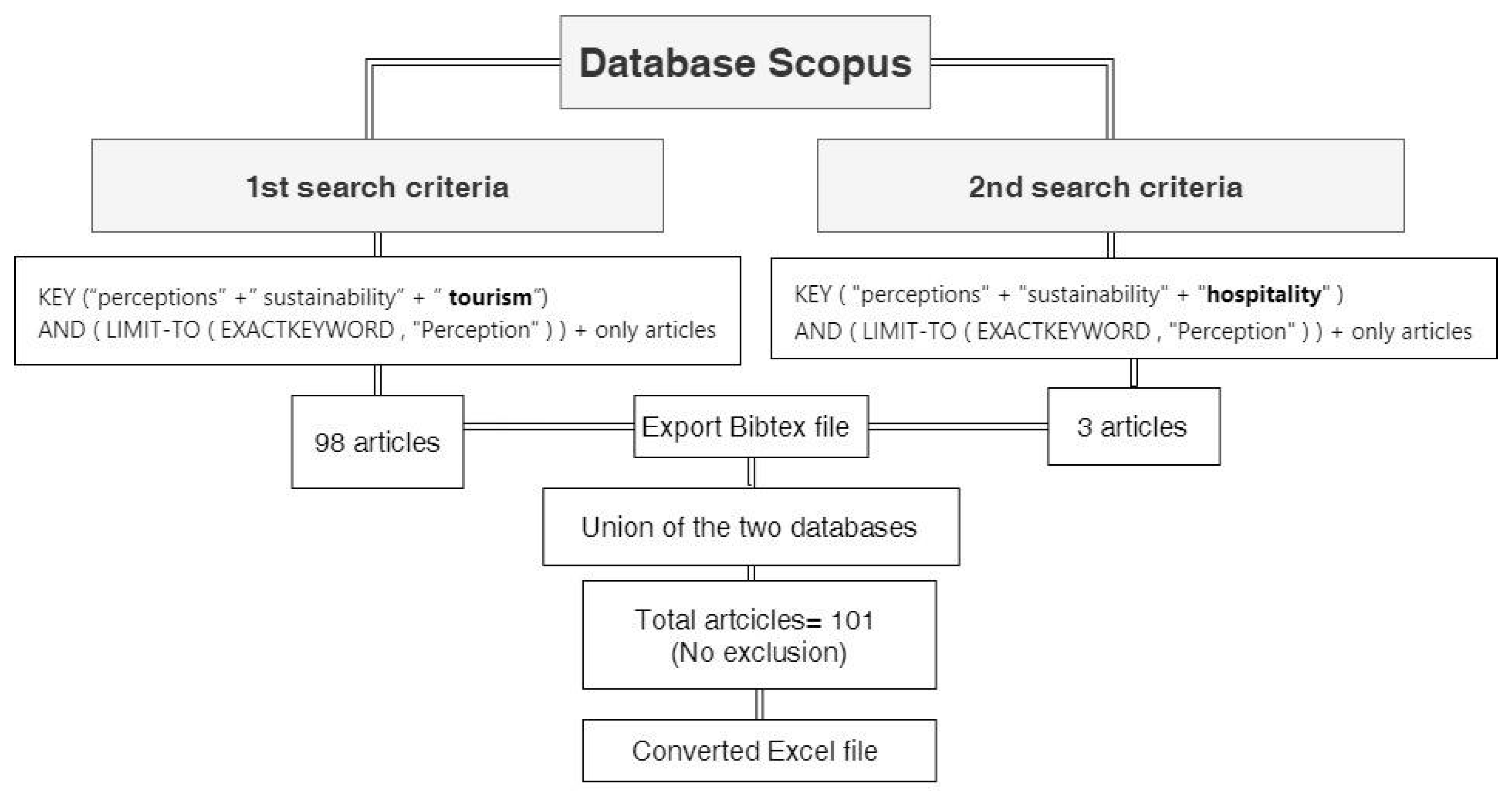
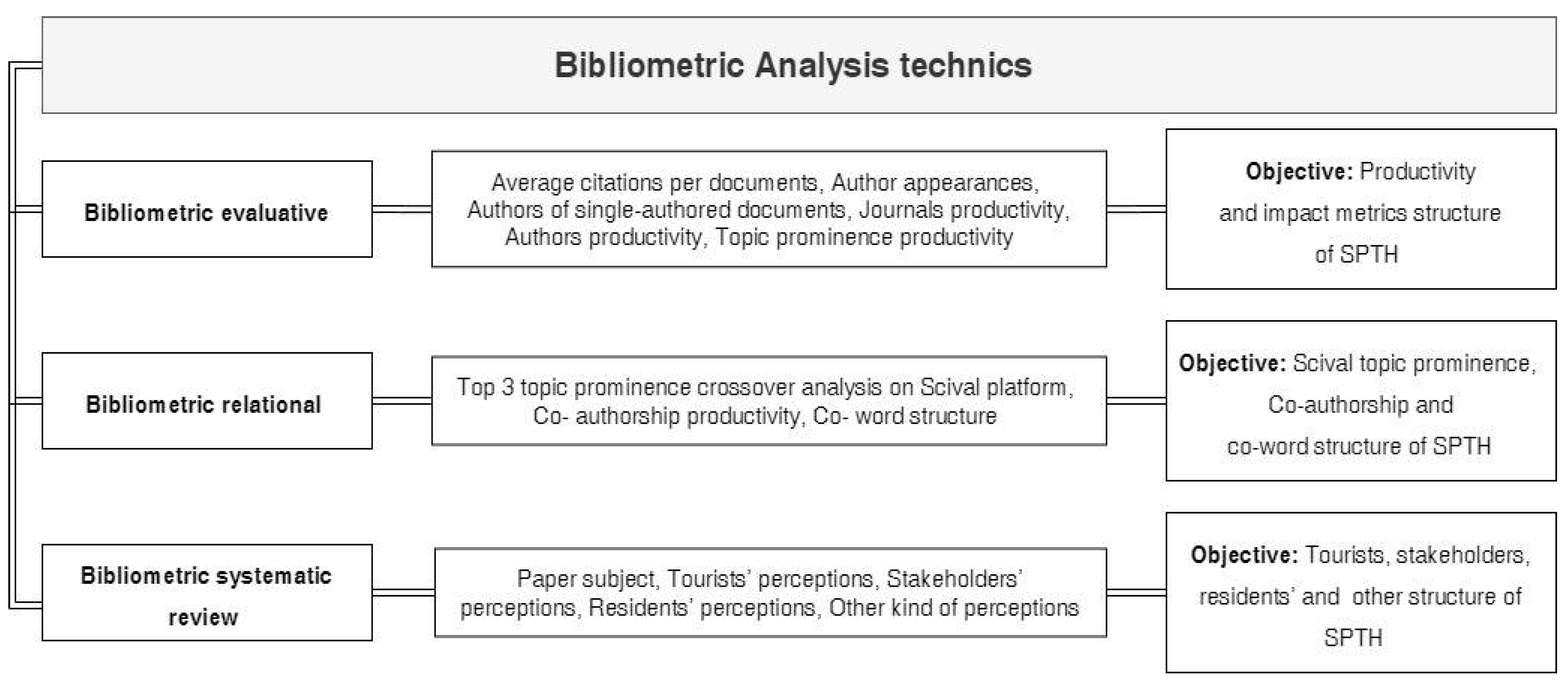
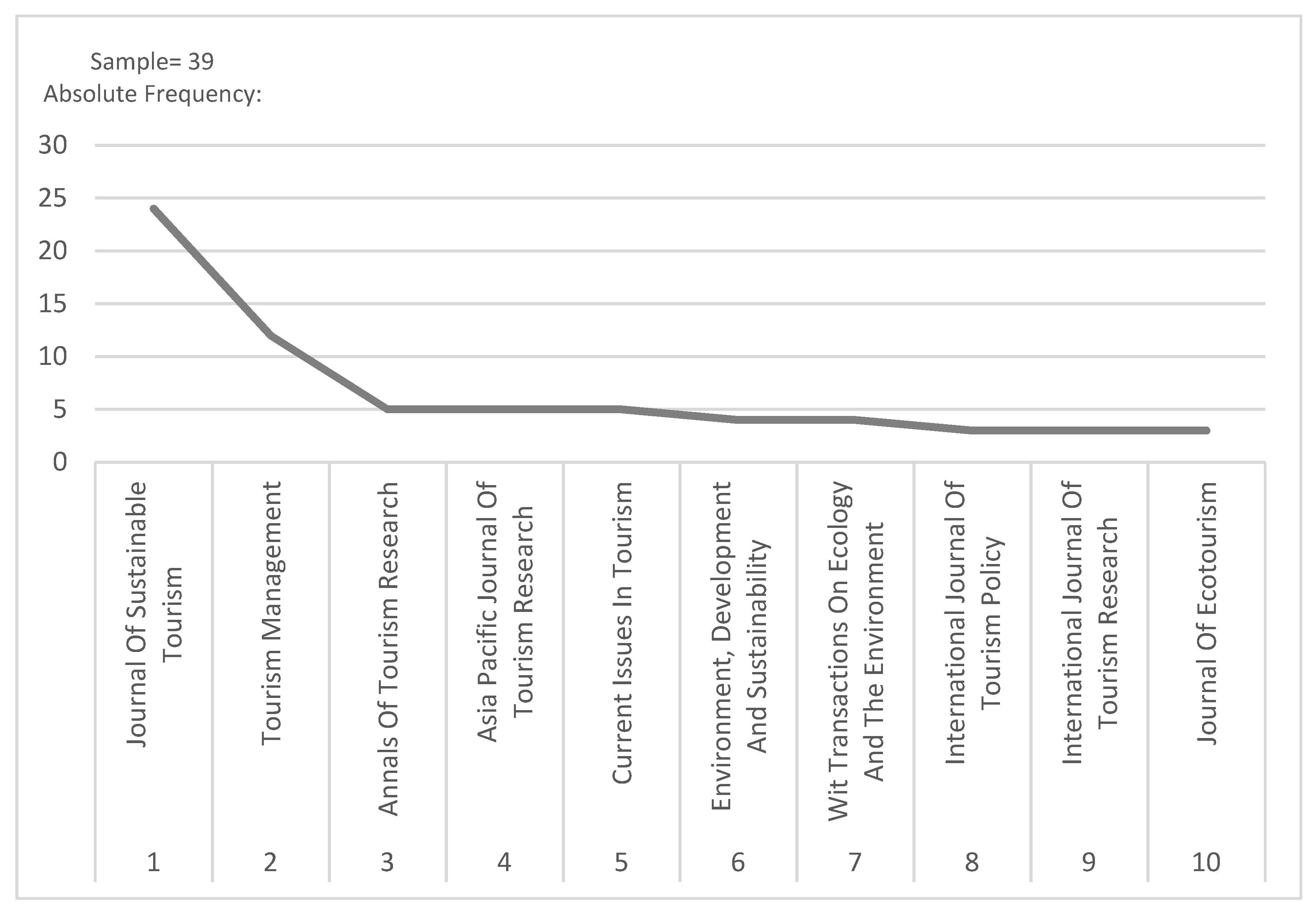
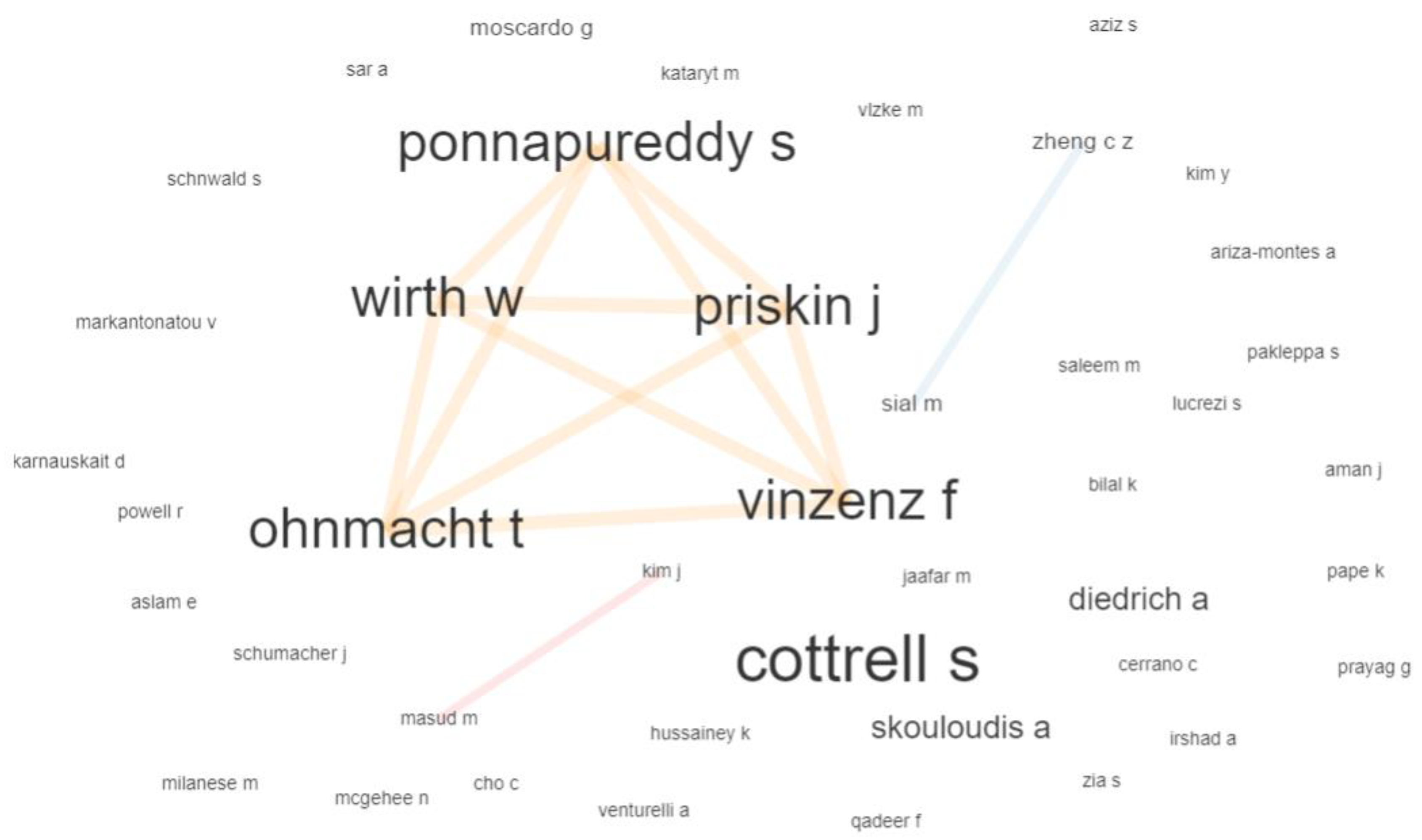
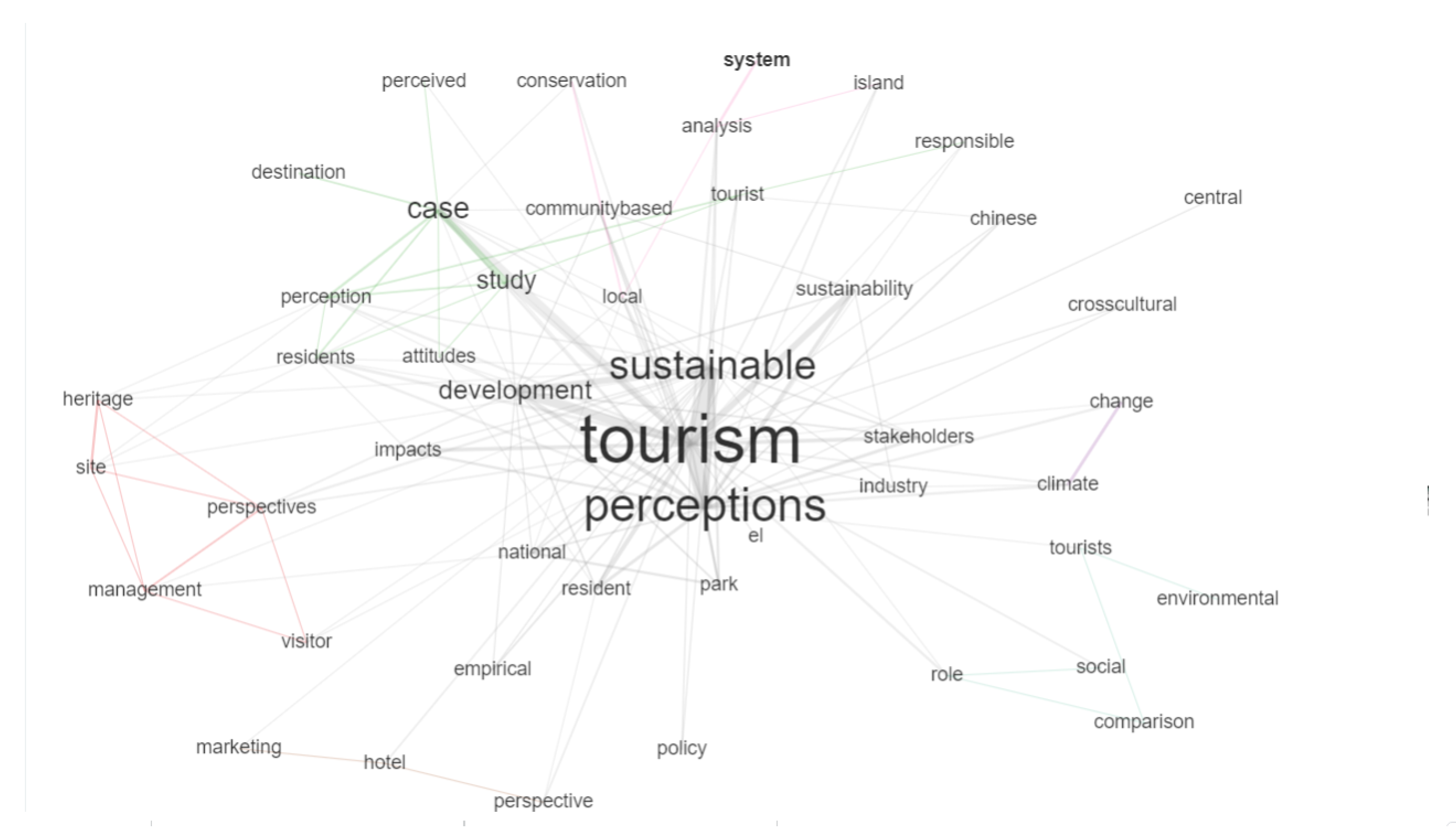

| Description of Main Information about Data | Results |
|---|---|
| Timespan | 2001–2020 |
| Sources (Journals) | 39 |
| Average years from publication | 5.58 |
| Average citations per documents | 21.07 |
| Average citations per year per document | 2.76 |
| References | 6207 |
| DOCUMENT TYPES | |
| Article | 101 |
| DOCUMENT CONTENTS | |
| Keywords Plus (ID) | 504 |
| Author’s Keywords (DE) | 372 |
| TOPIC PROMINENCE | 48 |
| AUTHORS | |
| Authors | 102 |
| Author Appearances | 310 |
| Authors of single-authored documents | 10 |
| Authors of multi-authored documents | 281 |
| AUTHOR COLLABORATION | |
| Single-authored documents | 10 |
| Documents per Author | 0.347 |
| Authors per Document | 2.88 |
| Co-Authors per Documents | 3.07 |
| Collaboration Index | 3.09 |
| Rank: | Authors: | Absolute Frequency: | Relative Frequency: |
|---|---|---|---|
| 1 | Moscardo G. | 3 | 0.009 |
| 1 | Ohnmacht T. | 3 | 0.009 |
| 1 | Ponnapureddy S. | 3 | 0.009 |
| 1 | Priskin J. | 3 | 0.009 |
| 1 | Vinzenz F. | 3 | 0.009 |
| 1 | Wirth W. | 3 | 0.009 |
| 1 | Altinay L. | 2 | 0.006 |
| 1 | Cottrell S. | 2 | 0.006 |
| 1 | Diedrich A. | 2 | 0.006 |
| 2 | Farmaki A. | 2 | 0.006 |
| 2 | Gursoy D. | 2 | 0.006 |
| 2 | Jaafar M. | 2 | 0.006 |
| 2 | Modica P.d. | 2 | 0.006 |
| 2 | Powell R.b. | 2 | 0.006 |
| 2 | Prayag G. | 2 | 0.006 |
| 2 | Ribas Palom A. | 2 | 0.006 |
| 2 | Thapa B. | 2 | 0.006 |
| 2 | Torres-bagur M. | 2 | 0.006 |
| 2 | Vila-subirós J. | 2 | 0.006 |
| 2 | Zenga M. | 2 | 0.006 |
| N = 48 Rank: | Variable Name: | Prominence Percentile | Absolute Frequency: | Years | Authors with more than 1 Paper | Universities |
|---|---|---|---|---|---|---|
| 1 | Tourism Development | Ecotourism | Destination Management | 99.523 | 37 | 2001(2); 2004(1); 2006(2);2007 (2) 2008(2); 2009(1);2010(4); 2011(1) 2013(1); 2014(3); 2015(3); 2017(7) 2018 (3); 2019 (3); 2020 (2) | Jaafar M. (2) Thapa B. (2) | Universiti Sains Malaysia. University of Florida, United States |
| 2 | Snow Making | Tourism Demand | Ski | 97.592 | 9 | 2011 (1); 2012 (1); 2013 (1); 2014 (1);2018 (1),2019 (3); 2020 (1) | Ribas Palom A. (2) Torres-Bagur M. (2) | University of Girona, Spain |
| 3 | Green Hotel | Hospitality Industry | Ecotourism | 96.841 | 6 | 2017 (2); 2019 (1); 2020 (3) | Altinay L. (2) Farmaki A. (2) | Oxford Brookes University, United Kingdom Cyprus University of Technology, Cyprus |
| 4 | Convention | Tokyo International Forum | Tourism | 98.808 | 2 | ----- | ----- | ----- |
| 5 | Dark Tourist | Heritage Tourism | Anzac | 90.929 | 2 | ----- | ----- | ----- |
| 6 | Destination Image | Tourist Satisfaction | Revisit Intention | 98.094 | 2 | ----- | ----- | ----- |
| 7 | Volunteer Tourism | tourist Experience | Orphanage | 88.688 | 2 | ----- | ----- | ----- |
| 8 | Destination Marketing | International Tourism | tourist | 63.203 | 1 | ----- | ----- | ----- |
| 9 | Botswanum | Democratic Party | Protectorate | 57.511 | 1 | ----- | ----- | ----- |
| 10 | Coral Reef | Diving | Marine Park | 77.561 | 1 | ----- | ----- | ----- |
| Worldwide Overall Performance | Tourism Development; Ecotourism; Destination Management T.946 | Snow Making; Tourism Demand; Ski T.8688 | Green Hotel; Hospitality Industry; Ecotourism T.19030 |
|---|---|---|---|
| Scholarly Output | 3475 | 1517 | 871 |
| Scholarly Output (growth %) | 344.2 | 122.9 | 150 |
| Citations | 36,966 | 21,172 | 11,636 |
| Field-Weighted Citation Impact | 1.19 | 1.46 | 1.06 |
| Citations per Publication | 10.6 | 14 | 13.4 |
| Views | 146,376 | 60,099 | 42,657 |
| Views per Publication | 42.1 | 39.6 | 49 |
| Field-Weighted View Impact | 1.91 | 1.68 | 2.02 |
| Citing-Patent Count (patent office: All Patent Offices) | 0 | 0 | 0 |
| N = 13,828 Rank | Abstract Word | N = Words: | Rank | Abstract Word | N = Words: |
|---|---|---|---|---|---|
| 1 | tourism | 313 | 21 | community | 44 |
| 2 | sustainability | 130 | 22 | climate | 43 |
| 3 | perceptions | 110 | 23 | support | 42 |
| 4 | development | 107 | 24 | industry | 40 |
| 5 | sustainable | 103 | 25 | destination | 39 |
| 6 | study | 91 | 26 | management | 39 |
| 7 | local | 83 | 27 | conservation | 38 |
| 8 | research | 74 | 28 | findings | 38 |
| 9 | tourist | 71 | 29 | positive | 38 |
| 10 | impacts | 70 | 30 | change | 37 |
| 11 | tourists | 66 | 31 | stakeholders | 37 |
| 12 | residents | 65 | 32 | perceived | 33 |
| 13 | social | 65 | 33 | communities | 32 |
| 14 | environmental | 63 | 34 | negative | 29 |
| 15 | between | 58 | 35 | practices | 27 |
| 16 | paper | 57 | 36 | cultural | 26 |
| 17 | Results | 56 | 37 | effects | 26 |
| 18 | perception | 53 | 38 | implications | 26 |
| 19 | more | 51 | 39 | destinations | 26 |
| 20 | economic | 49 | 40 | hotel | 25 |
| Tourists | Authors | Residents | Authors | Stakeholders | Authors |
|---|---|---|---|---|---|
| Consumer loyalty | Modica et al. (2020) | Tourism as a driving force (economic and territorial) | Dillette et al. (2017); Lucrezi et al. (2017); | Tourist safety | Pérez et al. (2017) |
| Expected benefits | Ponnapureddy et al. (2020) | Possible negative effects of tourism | Ahmadian et al. (2014); Cottrell et al. (2007); Dillette et al. (2017); Gong et al. (2019); Wang (2019) | Value for money | Pérez et al. (2017) |
| Tourist satisfaction destination | Jacobsen (2007) | Actions to promote sustainable tourism | Andrade et al. (2019) | Signposting | Pérez et al. (2017) |
| Impact treatment or service received | Garrod et al. (2006); Tasci et al. (2017) | Nature conservation areas | Gong et al. (2019); Lee et al. (2019); Törn et al. (2008) | Access | Pérez et al. (2017) |
| Climate change | Brouder and Lundmark (2011); Clemente et al. (2020); Torres-Bagur et al. (2019) | Environmental concerns | Cottrell et al. (2007); Gong et al. (2019); Nicholas et al. (2009) | Offer | Pérez et al. (2017) |
| Education | Liu et al. (2016) | Quality of life | Lee et al. (2019); Lucrezi et al. (2017); | Resource conservation (heritage and environmental) | Pérez et al. (2017) |
| Socialization | Liu et al. (2016) | Employed opportunities | Lee et al. (2019) | Investment | Kantarci (2006) |
| Ecological impacts | Andereck et al. (2007); Modica et al. (2020); | Cultural activities | Lee et al. (2019) | Weak management by local companies | Stoffelen et al. (2020) |
| Sustainability and sustainable energy | Liu et al. (2016); Munanura et al. (2016) | Pollution | Gong et al. (2019) | Sustainable development | Stoffelen et al. (2020) |
| Role of communication | Vinzenz et al. (2019) | Perception of tourism management | Lucrezi et al. (2017); Moyle et al. (2010); Zamani-Farahani and Musa G. (2009) | ||
| Perceived usefulness | Ponnapureddy et al. (2017) | Resilience (social, economic, and ecological) | Dibra and Golemi (2014) | ||
| Visitor impacts | Andereck et al. (2007); Modica et al. (2020); Towner and Orams (2016) | Resident affinity with the destination | Sheldon and Abenoja (2001) | ||
| Visitor perception | Hillery et al. (2001) | ||||
| Environmental, economic, and social attitudes | Nicholas and Thapa (2010) | ||||
| Policy planning | Liu et al. (2016) |
Publisher’s Note: MDPI stays neutral with regard to jurisdictional claims in published maps and institutional affiliations. |
© 2020 by the authors. Licensee MDPI, Basel, Switzerland. This article is an open access article distributed under the terms and conditions of the Creative Commons Attribution (CC BY) license (http://creativecommons.org/licenses/by/4.0/).
Share and Cite
Lima Santos, L.; Cardoso, L.; Araújo-Vila, N.; Fraiz-Brea, J.A. Sustainability Perceptions in Tourism and Hospitality: A Mixed-Method Bibliometric Approach. Sustainability 2020, 12, 8852. https://doi.org/10.3390/su12218852
Lima Santos L, Cardoso L, Araújo-Vila N, Fraiz-Brea JA. Sustainability Perceptions in Tourism and Hospitality: A Mixed-Method Bibliometric Approach. Sustainability. 2020; 12(21):8852. https://doi.org/10.3390/su12218852
Chicago/Turabian StyleLima Santos, Luís, Lucília Cardoso, Noelia Araújo-Vila, and Jose A. Fraiz-Brea. 2020. "Sustainability Perceptions in Tourism and Hospitality: A Mixed-Method Bibliometric Approach" Sustainability 12, no. 21: 8852. https://doi.org/10.3390/su12218852
APA StyleLima Santos, L., Cardoso, L., Araújo-Vila, N., & Fraiz-Brea, J. A. (2020). Sustainability Perceptions in Tourism and Hospitality: A Mixed-Method Bibliometric Approach. Sustainability, 12(21), 8852. https://doi.org/10.3390/su12218852








